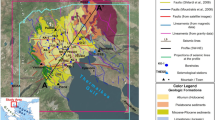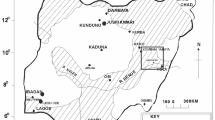Abstract
In this paper, we present a magnetic model of the subsurface structure of Vulcano island based on high-resolution aeromagnetic data. Three profiles across the most intense magnetic anomalies over the Piano and Fossa calderas were selected for the magnetic modelling, which was constrained by structural and volcanological data, previous geophysical models, paleomagnetic data, and borehole stratigraphy obtained from two deep wells. The interpretation of the magnetic sources represents a significant contribution to the understanding of the Piano and Fossa calderas’ underlying structure, providing us with evidence of the lateral discontinuity between them at depth. We propose that the positive magnetic anomalies in the Piano caldera area are caused by: (a) the remnants of an early submarine volcano; (b) an outcropping dyke swarm related to the feeding system of the Primordial Vulcano phase (beneath Mt. Saraceno); and (c) the presence of a non-outcropping dyke system intruded along a NE–SW-oriented intra-caldera fault (beneath the eastern part of the Piano caldera). Offshore, to the west, the magnetic anomaly map suggests the presence of a submarine volcanic structure, not revealed by bathymetric data, which could represent the eruptive centre, the presence of which has been indirectly deduced from the outcrop of eastern-dipping lavas on the western seashore. Magnetic modelling of the Fossa caldera points to the presence of a highly magnetized cone-like body inside the Fossa cone, centred beneath the oldest crater rims. We interpret this body as a pile of tephritic lavas emplaced in an early phase of activity of the Fossa cone, suggesting that the volume of mafic lavas that erupted at the beginning of the construction of the Fossa edifice was more significant than has previously been deduced. Furthermore, the presence of a magnetized body inside the Fossa cone implies that high temperatures are contained in very limited spaces, do not affect its bulk inner structure, and are restricted to fumarolic conduits and vents. In addition, structures beneath the western and northern part of the Fossa caldera are revealed to have null or low magnetization, which can be ascribed to the presence of pyroclasts and hyaloclastites in this area as well as to a large volume of hydrothermally altered materials. This suggests that the hydrothermal system, with a very limited extension at present, affected a larger area in the past, especially beneath the western part of the caldera.








Similar content being viewed by others
References
Ade-Hall JM, Palmer HC, Hubbard TP (1971) The magnetic and opaque petrological response of basalts to regional hydrothermal alteration. Geophys J R Astron Soc 24:137–174
Baranov V, Naudy H (1964) Numerical calculation of the formula of reduction to the magnetic pole. Geophysics 29:67–79
Barberi F, Innocenti F, Ferrara G, Keller J, Villari L (1974) Evolution of the Eolian arc volcanism (southern Tyrrhenian Sea). Earth Planet Sci Lett 21:269–276
Barberi F, Neri G, Valenza M, Villari L (1991) 1987–1990 unrest at Vulcano. Acta Vulcanol 1:95–106
Barberi F, Gandino A, Gioncada A, La Torre P, Sbrana A, Zenucchini C (1994) The deep structure of the Eolian arc (Filicudi–Panarea–Vulcano sector) in light of gravity, magnetic and volcanological data. J Volcanol Geotherm Res 61:189–206
Berrino G (2000) Combined gravimetry in the observation of volcanic processes in Italy. J Geodyn 30:371–388
Blanco-Montenegro I, Torta JM, Garcia A, Araña V (2003) Analysis and modelling of the aeromagnetic anomalies of Gran Canaria (Canary Islands). Earth Planet Sci Lett 206:601–616
Bonasia V, Luongo G, Montagna S (1973) A land gravity survey of the Aeolian Islands. Bull Volcanol 37:134–146
Budetta G, Nunziata C, Rapolla A (1983) A gravity study of the island of Vulcano, Tyrrhenian Sea, Italy. Bull Volcanol 46:183–192
Chiarabba C, Pino NA, Ventura G, Vilardo G (2004) Structural features of the shallow plumbing system of Vulcano Island Italy. Bull Volcanol 66:477–484
Chiodini G, Cioni R, Falsaperla S, Guidi M, Marini L, Montalto A (1992) Geochemical and seismological investigations at Vulcano (Aeolian Islands) during 1978–1989. J Geophys Res 97:11025–11032
De Astis G, Frazzetta G, La Volpe L (1989) I depositi di riempimento della Caldera del Piano e i depositi della Lentia. Boll GNV 2:763–778
De Astis G, La Volpe L, Peccerillo A, Civetta L (1997) Volcanological and petrological evolution of Vulcano island (Aeolian Arc, southern Tyrrhenian Sea). J Geophys Res 102(B4):8021–8050
De Astis G, Ventura G, Vilardo G (2003) Geodynamic significance of the Aeolian volcanism (southern Tyrrhenian Sea, Italy) in light of structural, seismological and geochemical data. Tectonics. DOI 10.1029/2003TC001506
De Ritis R, Blanco-Montenegro I, Ventura G, Chiappini M (2005) Aeromagnetic data provide new insights on the tectonics and volcanism of Vulcano island and offshore areas (southern Tyrrhenian Sea, Italy). Geophys Res Lett 32 (L15305). DOI 10.1029/2005GL023465
De Santis A, Gaya-Piqué L, Dominici G, Meloni A, Torta JM, Tozzi R (2003) Italian Geomagnetic Reference Field ITGRF: update for 2000 and secular variation model up to 2005 by autoregressive forecasting. Ann Geophys 46:491–500
Ellam RM, Hawkesworth CJ, Menzies MA, Rogers NW (1989) The volcanism of southern Italy: role of subduction and the relationship between potassic and sodic alkaline magmatism. J Geophys Res 94:4589–4601
Faraone D, Silvano A, Verdiani G (1986) The monzogabbroic intrusion in the island of Vulcano, Aeolian archipelago, Italy. Bull Volcanol 48:299–307
Favalli M, Karatson R, Mazzuoli R, Pareschi MT, Ventura G (2005) Volcanic geomorphology and tectonics of the Aeolian archipelago (southern Italy) based on integrated DEM data. Bull Volcanol 68:157–170
Finn CA, Morgan LA (2002) High-resolution aeromagnetic mapping of volcanic terrain, Yellowstone National Park. J Volcanol Geotherm Res 115:207–231
Frazzetta G, La Volpe L, Sheridan MF (1983) Evolution of the Fossa cone, Vulcano. J Volcanol Geotherm Res 17:329–360
Fulignati P, Gioncada A, Sbrana A (1999) Rare-earth element (REE) behaviour in the alteration facies of the active magmatic-hydrothermal system of Vulcano (Aeolian Islands, Italy). J Volcanol Geotherm Res 88:325–342
Gabbianelli G, Romagnoli C, Rossi PL, Calanchi N, Lucchini F (1991) Submarine morphology and tectonics of Vulcano (Aeolian Islands, southeastern Tyrrhenian Sea). Acta Vulcanol 1:131–141
Gillot PY, Frazzetta G, La Volpe L (1990) Volcanotectonic evolution of Vulcano (Aeolian Islands, southern Italy) from geochronological (K–Ar) study. Int Volcanol Congr (Mainz, September 3–8; abstract)
Gioncada A, Sbrana A (1991) “La Fossa caldera”, Vulcano: inferences from deep drillings. Acta Vulcanol 1:115–125
Gioncada A, Mazzuoli R, Bisson M, Pareschi MT (2003) Petrology of volcanic products younger than 42 ka on the Lipari–Vulcano complex (Aeolian Islands, Italy): an example of volcanism controlled by tectonics. J Volcanol Geotherm Res 122:191–220
Iacobucci F, Incoronato A, Rapolla A, Scarascia S (1977) Basement structural trends in the volcanic islands of Vulcano, Lipari, and Salina (Aeolian Islands, Southern Tyrrhenian Sea) computed by aeromagnetic and gravimetric data. Boll Geofis Teor Appl 20:73–74, 49–61
Italiano F, Nuccio PM, Valenza M (1984) Mass geothermal energy release at Vulcano, Aeolian Islands, Italy. Rend Soc Ital Mineral Petrol 39:379–386
Keller J (1974) Petrology of some volcanic rock series of the Aeolian Arc, southern Tyrrhenian Sea: calc-alkaline and shoshonitic associations. Contrib Mineral Petrol 45:29–47
Keller J (1980) The island of Vulcano. Rend Soc Ital Mineral Petrol 36:369–414
Keller J (1982) Mediterranean island arcs. In: Thorpe RS (ed) Andesites. Wiley, Chichester, pp 307–325
Lanza R, Zanella E (2003) Paleomagnetic secular variation at Vulcano (Aeolian Islands) during the last 135 kyr. Earth Planet Sci Lett 213:321–336
Lénat JF, Gibert-Malengreau B, Galdeano A (2001) A new structural model for the evolution of the volcanic island of Réunion (Indian Ocean). J Geophys Res 106(B5):8645–8663
Mazzuoli R, Tortorici L, Ventura G (1995) Oblique rifting in Salina, Lipari and Vulcano islands (Aeolian Islands, southern Italy). Terra Nova 7:444–452
Rasmussen R, Pedersen LB (1979) End corrections in potential field modelling. Geophys Prospect 27:749–760
Supper R, De Ritis R, Motschka K, Chiappini M (2004) Aeromagnetic anomaly images of Vulcano and southern Lipari Islands (Aeolian archipelago, Italy). Ann Geophys 47:1803–1810
Talwani M, Heirtzler JR (1964) Computation of magnetic anomalies caused by two-dimensional bodies of arbitrary shape. In: Parks GA (ed) Computers in the mineral industries, Part 1. Stanford Univ Publ Geological Sciences 9:464–480
Ventura G (1994) Tectonics, structural evolution and caldera formation in Vulcano island (Aeolian archipelago, southern Tyrrhenian Sea). J Volcanol Geotherm Res 60:207–224
Ventura G, Vilardo G, Milano G, Pino NA (1999) Relationships among crustal structure, volcanism and strike-slip tectonics in the Lipari–Vulcano volcanic complex (Aeolian Islands, southern Tyrrhenian Sea, Italy). Phys Earth Planet Int 116:31–52
Won IJ, Bevis M (1987) Computing the gravitational and magnetic anomalies due to a polygon: algorithms and Fortran subroutines. Geophysics 52:232–238
Zanella E, Lanza R (1994) Remanent and induced magnetization in the volcanites of Lipari and Vulcano (Aeolian Islands). Ann Geophys 37:1149–1156
Zanella E, De Astis G, Dellino P, Lanza R, La Volpe L (1999) Magnetic fabric and remanent magnetization of pyroclastic surge deposits from Vulcano (Aeolian Islands, Italy). J Volcanol Geotherm Res 93:217–236
Zanella E, De Astis G, Lanza R (2001) Palaeomagnetism of welded, pyroclastic-fall scoriae at Vulcano, Aeolian Archipelago. J Volcanol Geotherm Res 107:71–86
Acknowledgement
We would like to thank Elena Zanella for providing us with unpublished paleomagnetic data and Guido Ventura, Claudia Romagnoli, and Franco Barberi for fruitful discussions on the volcanic history of Vulcano. We are also thankful to Jean-François Lénat for his careful review of the manuscript and to Maurizio Ripepe for editing it. Isabel Blanco-Montenegro was supported by the Spanish Ministry of Education and Science (Secretaría de Estado de Universidades e Investigación, Ayuda de Movilidad PR-2004-0201) and the Universidad de Burgos (Spain).
Author information
Authors and Affiliations
Corresponding author
Additional information
Editorial responsibility: M. Ripepe
Rights and permissions
About this article
Cite this article
Blanco-Montenegro, I., De Ritis, R. & Chiappini, M. Imaging and modelling the subsurface structure of volcanic calderas with high-resolution aeromagnetic data at Vulcano (Aeolian Islands, Italy). Bull Volcanol 69, 643–659 (2007). https://doi.org/10.1007/s00445-006-0100-7
Received:
Accepted:
Published:
Issue Date:
DOI: https://doi.org/10.1007/s00445-006-0100-7




